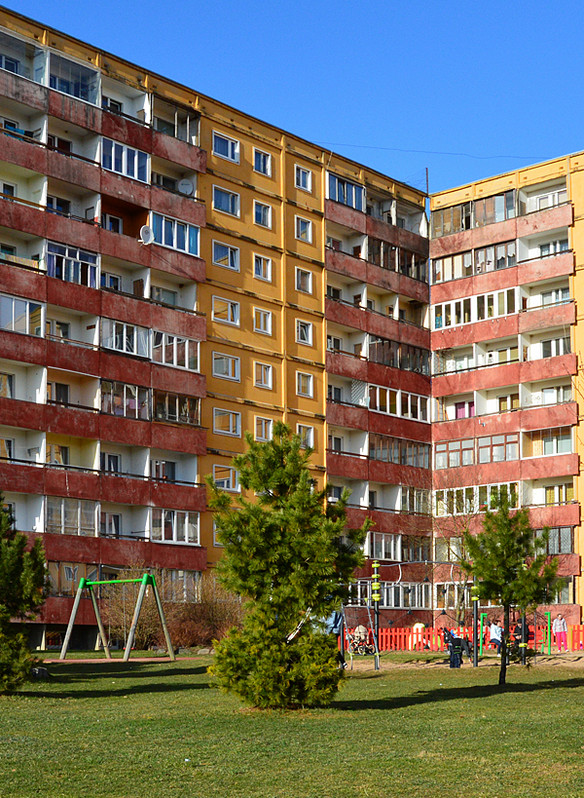Main Content
Large Housing Estates in Eastern Europe: Quite Normal Residential Areas

Although large housing estates in industrial construction were built in the post-war period both west and east of the Iron Curtain, there are striking differences in terms of their urban planning role and their perception. In Western Europe, they were mainly built in the context of social housing. In socialist countries, they represented the common form of housing construction and were inhabited by a wide range of population strata. While large housing estates in Western Europe housed disproportionately socially disadvantaged groups and quickly found themselves in a stigmatised position, their Eastern European counterparts evaded such a role simply because of their great quantitative importance. For example, large housing estates in Slovakia today account for about 80 % of the total housing stock! This difference is problematic insofar as the discussion in urban and planning research is dominated by the (Northern) Western European perception. As a result, a well-founded discussion of the development potential of Eastern European large housing estates suffers.
Together with partners from the University of Tartu (Estonia) and the European University at St. Petersburg (Russia), a team from the IRS in the project “Estates after Transition – Großwohnsiedlungen nach der Transformation” (EAT) took a comparative look at the development conditions of large housing estates in Russia, Estonia and East Germany based on case studies of six residential areas. The researchers asked about the perspectives for action and control and their embedding in larger socio-economic trends. The project's aim was to move away from individual case studies towards a systematic classification and thus to expand the scientific view of large housing estates to include an Eastern European perspective. The transferability of planning and urban policy best practices was also a topic.
As it turned out, an opening of the discourse is urgently needed, both in terms of problem diagnoses and solutions. In post-socialist countries, flats in large housing estates were extensively privatised in the 1990s, mostly individually, to their residents, who belong to (almost) all social classes. This means that two common diagnoses from Western European discourse do not apply: segregation, a major problem from French banlieues to British estates, is not a pressing issue in Eastern European large housing estates. At the same time, there is no over-commitment of public landlords, quite the contrary. Whereas in Western Europe a diversification of ownership structures is often recommended, in Eastern Europe there is rather the problem of too much fragmentation of ownership. From the financially weak pensioner to the young first-time home buyer to the professional landlord, a wide range of diverging interests are occur on the housing market. This leads to coordination problems. For example, who takes care of the building envelope and the outside areas? The boundaries of private ownership are also often unclear. In Tallinn, buyers could decide where the property should end: directly at the house wall or at a freely chosen distance of up to 20 metres. For each building, the new ownership groups made their own decisions, so that now the responsibilities for outdoor spaces are highly fragmented.
Policy recommendations from Western European discourse often assume a state capable of steering. They presuppose the existence of subsidy programmes, strong public housing companies, financial and human resources in ministries and (planning) administrations, competent private planning offices, experience with model processes and a tradition of state housing market intervention in a market economy environment. None of these conditions is fulfilled in post-socialist countries. There is no institutionalised experience and competence, nor are there sufficient financial resources after decades of austerity policies. In contrast, there is experience with negotiated solutions between very heterogeneous actors.
Against this background, many best practice suggestions from the academic discourse on large housing estates prove to be unsuitable for Eastern Europe. However, it also became apparent that the institutional landscapes in Eastern European countries themselves are very diverse and the transfer possibilities of political concepts within Eastern Europe are very limited. International dialogue, not only in academic circles but also among planning practitioners, on the other hand, is perceived as very productive and desirable. This is where knowledge transfer efforts in international planning research can come in.
East Germany, by the way, can be seen as a mixed case between the East and West European models. Here, too, flats were privatised on a large scale, but not to the tenants, but to private companies, so that today in many housing estates up to a third of the flats are in the hands of financial investors. Socially, some, but by no means all, East German housing estates have moved close to hotspots like West German Cologne-Chorweiler in recent years. However, socio-economic downward trends are very clearly visible. In terms of state options for action, East Germany is more in line with the Western European model, with still considerable state intervention capacities and a deeply rooted planning culture. Urban planning and socio-political concepts such as those applied in the case study areas of Berlin-Marzahn and Halle-Neustadt are not available to Eastern European large housing estates.
The results of the EAT project will be included in a special issue of the Journal of Housing and the Built Environment, which is expected to be published in 2023 and will contain articles on large settlements in the UK, France, Northern Macedonia, Finland, Estonia, Lithuania and Russia. First articles from EAT have already been published online. Housing policy conclusions will be published soon on the blog of the EU-funded urban development platform URBACT.
The project “Estates after Transition” ran from July 2018 to November 2021 and was funded by the German Federal Ministry of Education and Research (BMBF) as part of the ERA.NET Plus with Russia funding programme. The project was coordinated by Matthias Bernt (IRS).


